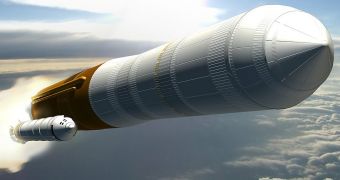Ares V is the new Cargo Launch Vehicle under development at NASA, part of the Project Constellation, aimed to out people on the Moon, again and on Mars, for the first time. Though the rocket is still on the drawing board, scientists are thrilled about what it could carry into space.
"The Ares V rocket will be able to launch missions whose volume or mass or both can be handled no other way," says Philip Stahl, an internationally respected optical engineer now at NASA's Marshall Space Flight Center.
The biggest space telescopes ever produced will fit inside the new ship and one of these, 6 to 8 meters (18-26 ft) long, would make the Hubble Space Telescope's 2.4 meters (7 ft) mirror look like a dwarf. The launch vehicle will be able to carry about 130 metric tons (287,000 lb) to Low Earth orbit (LEO) and 65 metric tons (143,300 lb) to the Moon.
This is 8 percent more than Saturn V rocket of the 1960s, the most powerful launch vehicle ever brought to operational status, the one that got the manned Apollo spacecraft on the surface of the Moon.
But the real breakthrough will be to put satellites in the Lagrangian points, 5 "parking spots" in space where every spacecraft remains in a fixed position relative to the Sun and Earth, making it the ideal place for solar and space observatories, giving any telescope located there a wide and unobstructed view of deep space.
Imagine an optical telescope with a primary mirror up to 8 m (26 ft.) in diameter, located in one of the Lagrangian points, continuously searching for "Earthshine spectra" faint signs of life in the light reflected by exoplanets.
This telescope would have a resolution more than three times sharper than the one of Hubble and its mirror would be able to see objects 11 times fainter than currently possible, due to the area of the mirror, 11 times greater.
It will be like a huge telescope mounted on top of Mount Everest, only without the blur effects caused by Earth's atmosphere.

 14 DAY TRIAL //
14 DAY TRIAL //